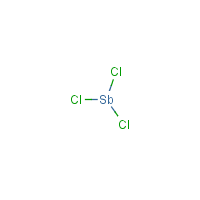Antimony trichloride
Agent Name
Antimony trichloride
CAS Number
10025-91-9
Formula
Cl3-Sb
Major Category
Metals

Synonyms
Antimoine (trichlorure d') [French]; Antimonio (tricloruro di) [Italian]; Antimonous chloride; Antimontrichlorid [German]; Antimony butter; Antimony chloride; Antimony chloride (Sb2Cl6); Antimony chloride (SbCl3); Antimony trichloride (Sb2Cl6); Antimony(III) chloride; Antimoontrichlride [Dutch]; Butter of antimony; C.I. 77056; CI 77056; Caustic antimony; Chlorid antimonity [Czech]; Chlorure antimonieux [French]; Stibine, trichloro-; Trichlorostibine; Trichlorure d'antimoine [French]; [ChemIDplus] UN1733
Category
Metalloid Compounds (Antimony)
Description
Colorless solid; Very hygroscopic; [Hawley] Solution: Yellow to reddish-brown liquid; [Merck Index] Off-white crystalline solid; [MSDSonline]
Sources/Uses
Used as a reagent for molecular weight determinations and identification of drugs and as a mordant, chlorinating agent, polymerization catalyst, hydrocracking agent (coal and heavy hydrocarbons), veterinary dehorning agent, and intermediate; [HSDB] Used to make antimony salts, pharmaceuticals, and fireproof textiles; [Hawley] Used for bronzing iron (especially gun barrels) and coloring zinc black, as a mordant for dyeing cloth and patent leather, and in manufacturing lakes and furniture polishes; [Merck Index]
Comments
A corrosive substance that can cause injury to the skin, eyes, and respiratory tract; Can cause pulmonary edema; May have adverse effects on the heart; [ICSC] Causes myocardial degeneration and death in feeding studies of rats for 10 days at 135 mg/kg; [HSDB] Reacts violently with water; A corrosive substance that can cause injury to the skin, eyes, and respiratory tract; Inhalation may cause chemical pneumonitis; [MSDSonline] See "Antimony" and linked occupational diseases.
Biomedical References
Exposure Assessment
TLV (ACGIH)
0.5 mg/m3, as Sb
PEL (OSHA)
0.5 mg/m3, as Sb
IDLH (NIOSH)
50 mg/m3, as Sb
Explanatory Notes
VP = 1 mm Hg at 49.2 deg C (sublimes); [HSDB]
Adverse Effects
Toxic Pneumonitis
Yes
Hepatotoxin
Hepatoxic (a) from occupational exposure (secondary effect) or (b) in animal studies or in humans after ingestion
Dermatotoxin
Skin burns
IARC Carcinogen
Probable (2a)
Diseases, Processes, and Activities Linked to This Agent
Processes
Industrial Processes with risk of exposure: